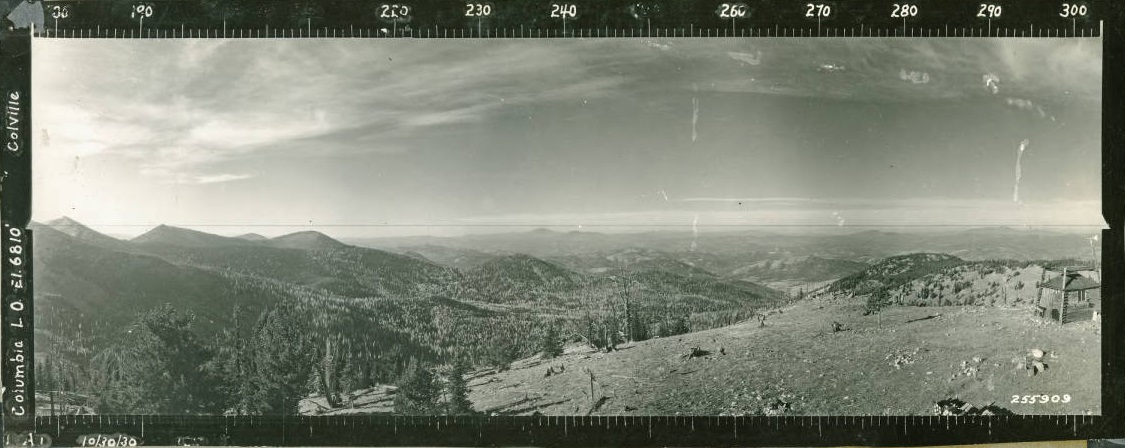
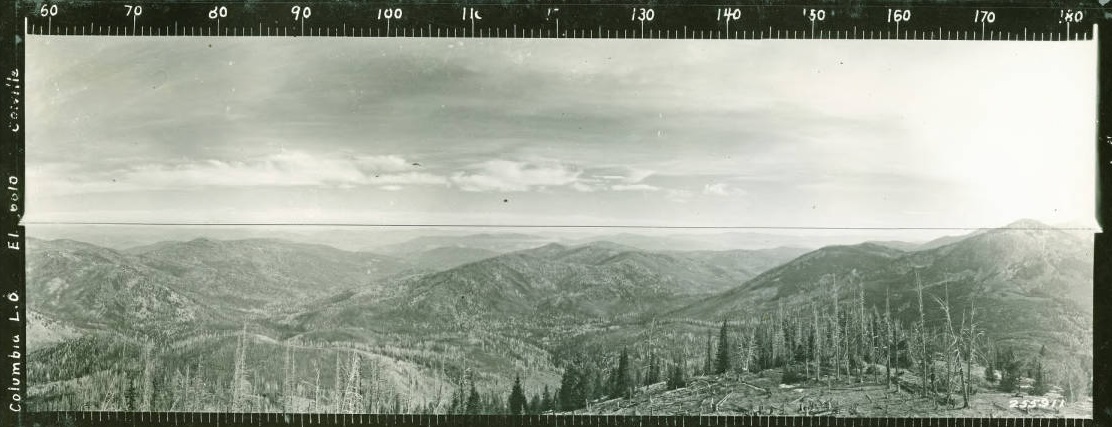
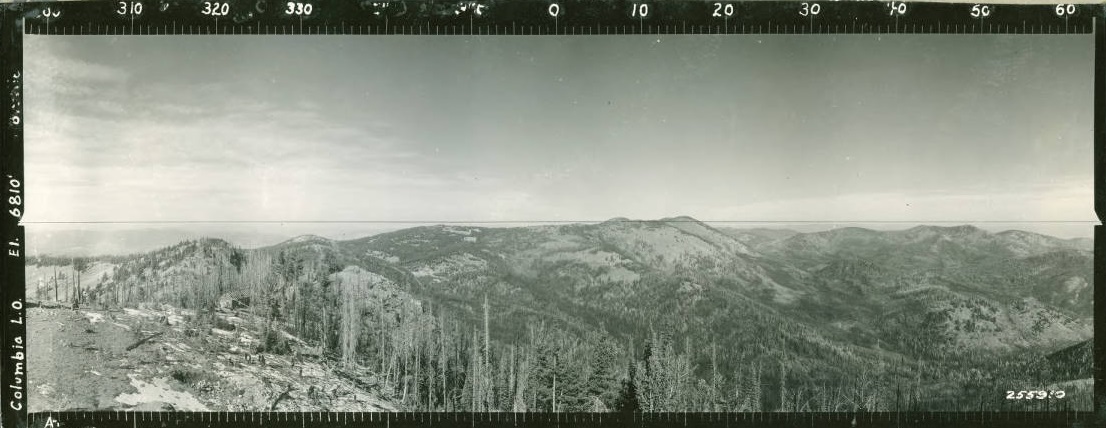


Columbia Mountain Lookout Site
Elevation: 6,782 feet
Hiking Distance: 2.5 miles
Elevation Gain: 1,400 feet
Access: Paved
WillhiteWeb.com: Fire Lookouts
Looking North 1930
Looking Southeast 1930
Looking Southwest 1930
From the Southwest view 1930 panoramic
Bringing up building materials

Columbia Mountain first started with a camp and stone shelter in 1912. In 1914, the current hand-hewn square log cabin was built. Although this cabin was the living quarters, the structure originally had a 15 foot pole platform tower attached above it. Later in 1928, a 16 foot pole live-in tower replaced the cabin. The platform was removed from the cabin at some point. Some minor preservation of the cabin started in the early 2000s by volunteers from the Colville National Forest and Washington Chapter of the Forest Fire Lookout Association, with a major preservation effort in 2010, including replacement of multiple logs and the roof. The building is now on the National Historic Lookout Register, and is a twin of the one on Mt. Bonaparte. The 1928 tower and cab lasted into the 60s but are now gone but debres remain.
Access:
Take Highway 20 to Sherman Pass and park in the large signed trailhead.
Route:
Follow the Kettle Crest Trail northbound to the historic spring used by the lookouts for water. Just past the spring, the Columbia Mountain trail switchbacks to the right. Follow this trail to a Y that says there is a summit loop. I went left and the trail went to the summit. I could not find the return loop at the summit so I went down the same way.
This amazing collection of news stories was collected by Ron Kemnow. Find his books on Amazon!
August 8, 1913: Dan Robinson and a crew of men in the Forest Service are building an observation tower on the summit on the Kettle Falls road which will be a valuable asset to the forest fire patrol. They have recently built many miles of trail and phone line. (Republic News=Miner)
August 14, 1914: The stations at Sherman and Bonaparte, the highest peaks in this half of the reservation, enable the rangers to keep a close watch of practically the entire territory. (The Republic News-Miner)
August 21, 1914: The fire as reported early in the week from Columbia look-out is in an inaccessible region and in order to reach it the men will have to cut a trail for fully two miles through a heavily wooded region. According to clerk Barrett the fire is believed to have been started by lightning. (The Republic News-Miner)
August 6, 1915: Forest Guard, Hugh McIntosh is now on the Columbia lookout station at the summit east of Republic. In case the telephone system becomes damaged by storm we may expect the heliograph to surprise a few of us in the daytime since the lookout is in sight of Republic. Should flashes appear there at night it may be the signal of approach of some lost dirigible in distress, from foreign parts. (The Republic News-Miner)
September 17, 1915: The local office of the Forest Service have completed the field work for the present season and will relieve the guards from duty. Lookout towers for fire detectives were built on Sherman, Bonaparte, Vulcan and First Thought mountains. (The Republic News-Miner)
August 31, 1917: The lookout station on the Kettle Falls road is threatened by a big forest fire which started this morning and which is believed to be of incendiary origin. For several days the road over the summit will be closed to travel. (The Republic News-Miner)
August 9, 1918: Richard Price of Republic is stationed at the Look Out Station of the forest service on the Kettle Falls summit. He expects to remain there until October 1, or until the danger of the fire season is over. While Mr. Price is isolated from any neighbors he is quite happy and finds little time to be lonely. By means of the forest service telephone he can communicate with his family in Republic any time he wishes. By this means, too, he hears all the latest war news and other items interest as some member of the family reads the newspaper to him over the phone each day. Mrs. Price goes to Summit once each week to take him provisions and water. She makes the trip by horse and buggy until she strikes the trail leading from the main road to the summit, a distance of six miles, when she goes horseback the rest of the way. She gets water from the sparkling mountain spring on the trail about a mile from the station. (The Republic News-Miner)
August 1919: Mrs. Gladys Murray, a magazine writer, will have charge of the Columbia Lookout station, fourteen miles east of Republic, this season for the Colville National Forest. She intends to write an account of her experiences as a Forest Lookout for "Outdoor Life. (Six Twenty-Six)
October 1919: Gladys Murray, Columbia Lookout, Colville National Forest, has the distinction of being the first woman in Ferry County, perhaps in Washington State, of killing a deer the first day of season. This fine aforesaid fourteen point buck above stated, killed by said Lookout, had been eating what grass the sheep had left for her horse Waulux during the summer and said huntress swore revenge. So, rising early Oct. 1, she took her trusty rifle and hiked for the sound of the horse bell, when, as anticipated said buck was devouring grass quite with impunity. One shot back of the ear ended this wayward buck's checkered and bold career. (News Miner - Republic)
November 1919: " 'IMPRESSIONS OF A LOOKOUT JOB' by Gladys Murray"
To me the longing for adventure comes with the first breath of spring. When the call comes too strong I don my riding togs, pack my saddle bags and start upon some new adventure. Several years ago this spirit of adventure led me on a two thousand mile trip on horse-back alone. This year it prompted me to the Colville National Forest to handle the Columbia Lookout. To be a lookout one must have a spirit for adventure, a love for the wilderness and a sense of humor, to like it. The rangers replenished my woodpile and kept an 80 gallon tank filled with water for general use. The drinking water I carried in canvas water bags upon my saddle pony from the spring twenty minutes below the top of the mountain at dusk after vision became less clear so that I might be permitted to abandon my vigil upon the watch tower temporarily. On the way to the lookout I jumped a fawn within one mile of Kettle Falls road and a doe stood upon an embankment just off the Kettle Falls road and calmly watched our pack train pass. The trail to the top was very steep and we did not reach the station until late evening. There was still snow lying drifted to the north of the cabin, but wonder of wonders, flowers were in blossom within a few feet of the drift, this was the first of July, and that night water froze in the canvas water bags. Does this seem possible? Coming from almost sea level to an altitude of more than a thousand feet caused a dizzy, sleepy sensation which in time I overcame. I can understand how one might sleep upon the tower and pass up a fire but I have proof that I did not do this. At first the strenuous climb from the spring tired me very much but later I could hike without difficulty, and at the end of the season I remained a week with my mother to participate in a deer hunt which the rangers staged for me as a reward of merit. Before I left I could walk for miles through windfalls while hunting; by the way I killed a fourteen point buck and helped pack it to camp. Being a lookout was quite an experience this year for it was probably the worst fire season the west has known. During July and August I located and reported fifty fires. I was provided with the standard Osborne fire finder, which can be mastered in a moment and is accurate and durable and defies the heaviest gales. There were a number of electric storms and very little rain. It is a wonderful sight to witness an electric storm about the adjacent peaks at this altitude. Several times I saw lightning strike a tree and once saw it plainly start a fire which was at an altitude that it could not spread but died out on its own accord. Many of the worst fires were caused by lightning. The larger fires drove out many bears which caused the sheepmen no end of trouble. Two bears one night killed eleven sheep out of a band ranging upon my mountain and about fifty minutes hike from my cabin. One night I shall well remember. A terrible wind storm came up. It roared up the canyons like a storm at sea, whipped and lashed at my tent until it blew flat, though anchored to logs with wires and ropes, and drove me into the base of the lookout tower which was solid block log building about 11x11 feet with sloping walls. Eleven forest fires were burning in different directions which the wind fanned to fury and the ridges for miles into Canada and south into the Indian Reservation looked like well lighted distant cities that night. The moon came up full, and the color was copper. To stand outside the cabin was barely possible. This storm rather frightened me but before leaving the Lookout I experienced many more equally severe so they became just one more incident to make up an adventure. During the fire season the Lookout is a very important personage. He is the retina of the fire fighting organization of the U.S. Forest Service. The communication is instant by telephone, which the rangers keep constantly in order. The missing of one small fire might mean the loss of millions of feet of timber and a cost of a large sum of money for fighting it and even the loss of human life. The Forest Supervisor kindly approved my request for a warm log cabin for next year and a sturdy building is now ready to roof and receive its windows. I like the job and the forest bunch likes me so it won't be difficult for me to return next year." (Six Twenty-Six)
August 27, 1920: Mrs. Mike Moran and daughter have been spending the week at Columbia Lookout. (Republic News-Miner)
June 28, 1930: Edward Walden left Thursday for the Columbia lookout in the Kettle Falls district. Because Ed is in charge of the switchboard for the lookouts, he was scheduled to be at his post earlier than the others. (The Colville Examiner)
December 1932: While inspecting Columbia Lookout on this Forest, during the past season I noticed a small patch of bare ground that showed some evidence of having been turned over. Upon making inquiry of the lookout in regard to this phenomenon, I learned that two years ago he had attempted to raise a garden. In this garden he had planted beets, Swiss chard, radishes, onion sets, and lettuce. Columbia Lookout is at an elevation of 6810 feet and is located approximately 26 miles south of the Canadian line. The results of the garden are as follows: Beets and Swiss chard never showed up. A few radishes came up, they were extremely woody and died at an early age. The onion sets before they wilted gained nothing but strength. One lettuce plant came up; it developed two leaves, one 1-1/2 by 1 inches in size and the other 1/2 inch in diameter. The lookout diligently packed water to the lone plant, but failed to make any headway, apparently having all it could do to support the two leaves already produced. To climax the whole affair a band of sheep came over Columbia Mountain and one of them devoured the lettuce plant. J.B. Hogan (Six Twenty-Six)
July 7, 1933: Mr. and Mrs. Edward Walden the newlyweds at Columbia lookout, had guests visit them on the Fourth. (Republic News-Miner)

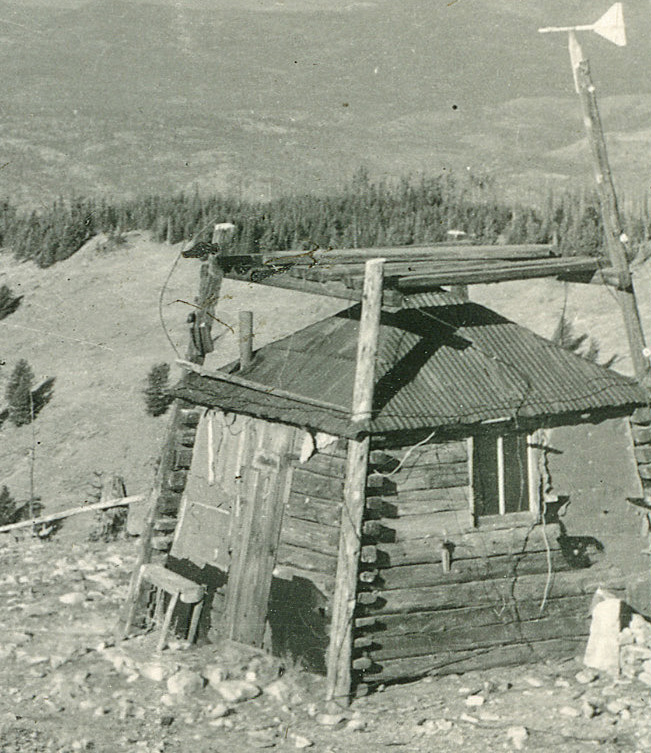
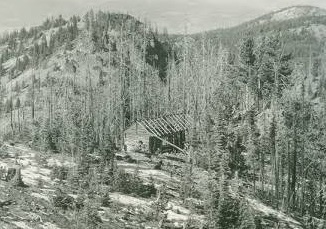
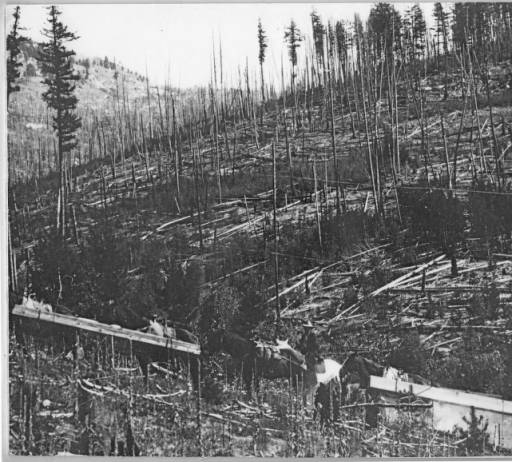
In the north panoramic in 1930 is this cabin under construction hiding down the north ridge where the old fireplace is today.
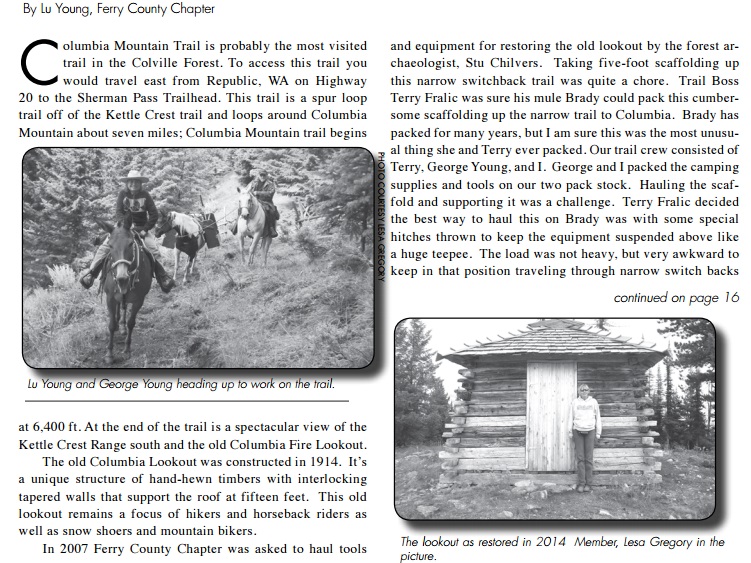
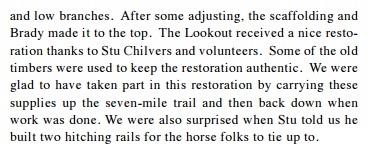
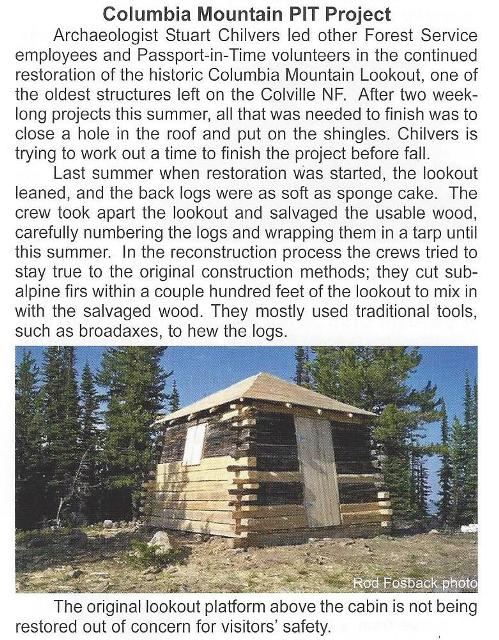
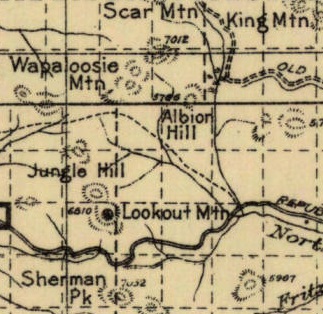
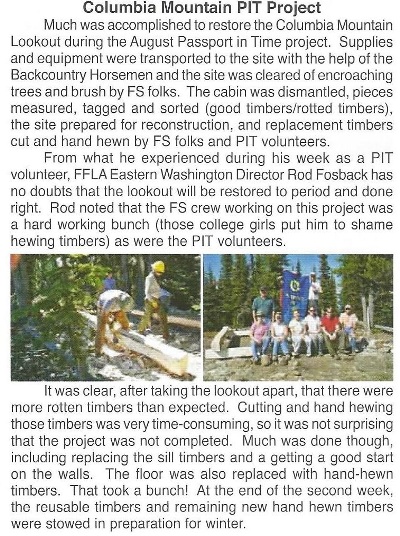
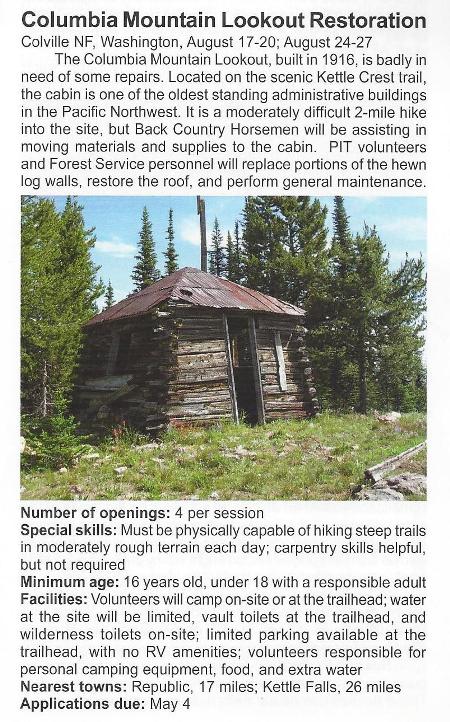
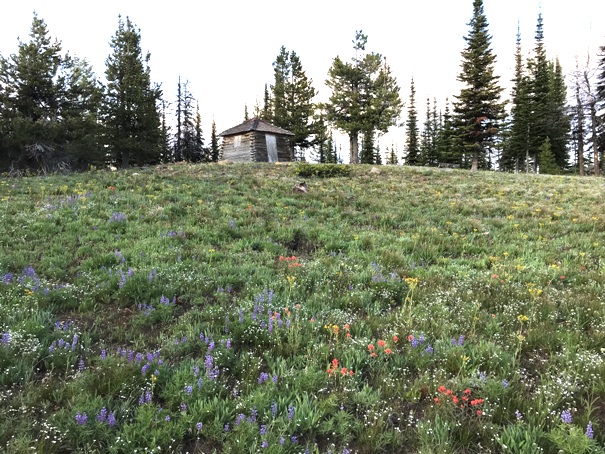
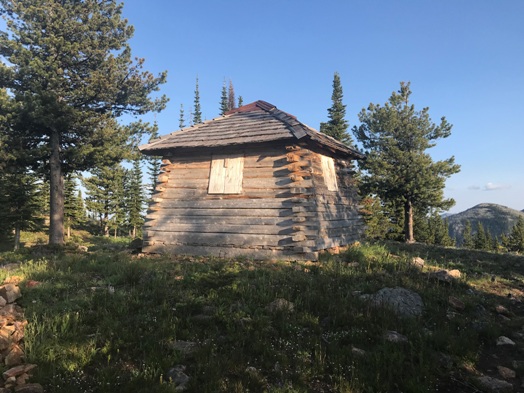
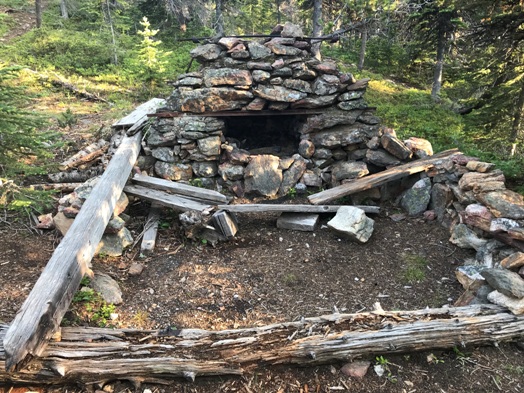
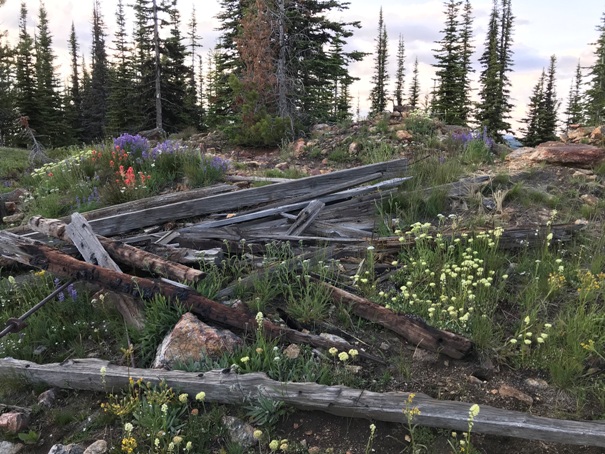
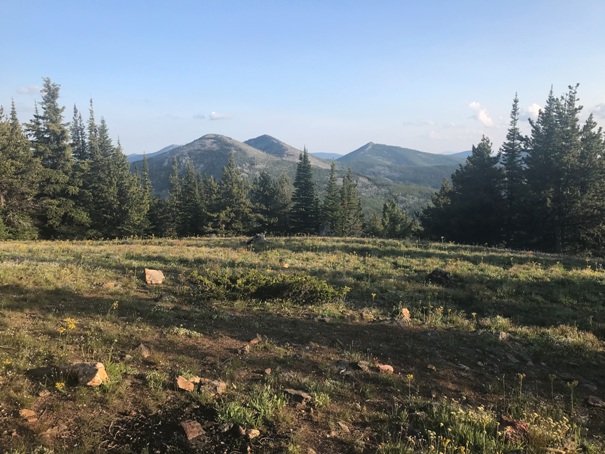
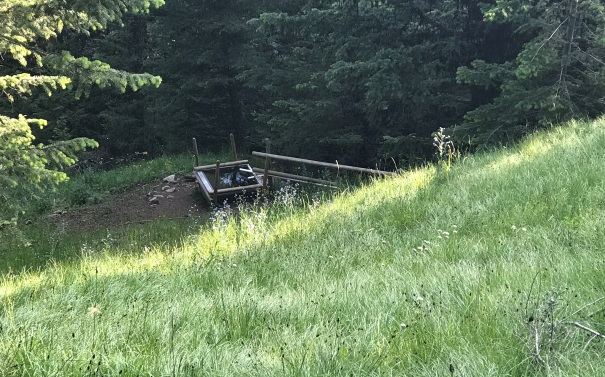

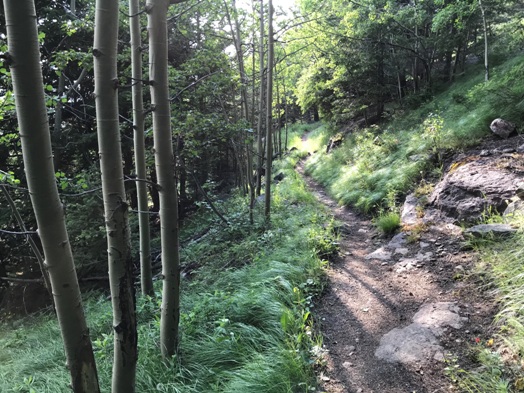
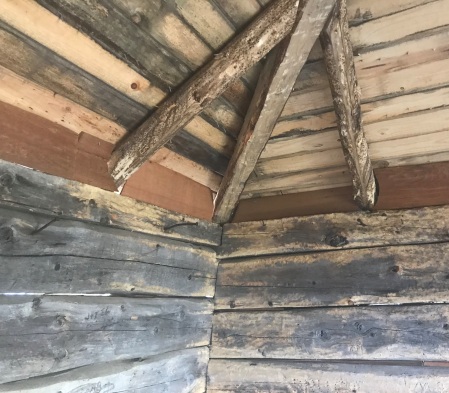

1917 map showed the site as Lookout Mountain
The 1928 tower parts getting burried
Looking down at Columbia Spring from the trail
The 1928 tower parts
Columbia Mountain Trail
Benches and campfire ring next to the old cabin lookout
Views of the Kettle Crest peaks, looking south
Old cabin site down a few hundred feet fromt the lookout sites
The summit of Columbia now growing trees
Columbia Mountain lookout
Inside Columbia Mountain lookout

























